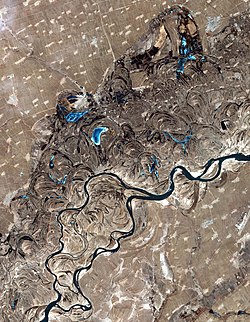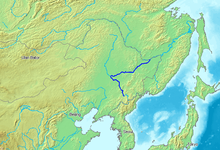সংহুয়া নদী: সংশোধিত সংস্করণের মধ্যে পার্থক্য
→Geography: কাজ চলছে |
|||
| ২৮ নং লাইন: | ২৮ নং লাইন: | ||
In November 2005, the river was [[Jilin chemical plant explosions 2005|contaminated with benzene]], leading to a shutdown of Harbin's water supply.<ref>{{cite web|url=http://english.cctv.com/program/newshour/20100322/102807.shtml|title=Water pollution in China alarming, CCTV.com}}</ref> The spill stretched {{convert|80|km|mi}} and eventually reached the Amur (Heilong) River on the [[China–Russia border]].<ref>{{cite book|url=https://books.google.com/?id=eAUImCyjIcQC&pg=PA245&dq=songhua+river#v=onepage&q=songhua%20river&f=false|title=China By Organisation for Economic Co-operation and Development, p.245|year=2007|isbn=9789264031159}}</ref> On July 28, 2010, several thousand barrels from two chemical plants in China's Jilin City were washed away by [[2010 China floods|floods]]. Some of them contained {{convert|170|kg|lb}} of explosive material like [[trimethylsilyl chloride]] and [[hexamethyldisiloxane]].<ref>[http://english.ruvr.ru/2010/07/30/13882208.html Khabarovsk Region prevents poisoned Sungari water from reaching Amur], Jul 30, 2010, Moscow Time</ref><ref>{{in lang|ru}}[http://eco.rian.ru/danger/20100730/259853392.html Defence lines were opened in attempt to intercept the barrels with chemicals], [[RIA Novosti]], 30.07.2010</ref> In 2016, the part near the city of Jilin was affected by a minor flood. |
In November 2005, the river was [[Jilin chemical plant explosions 2005|contaminated with benzene]], leading to a shutdown of Harbin's water supply.<ref>{{cite web|url=http://english.cctv.com/program/newshour/20100322/102807.shtml|title=Water pollution in China alarming, CCTV.com}}</ref> The spill stretched {{convert|80|km|mi}} and eventually reached the Amur (Heilong) River on the [[China–Russia border]].<ref>{{cite book|url=https://books.google.com/?id=eAUImCyjIcQC&pg=PA245&dq=songhua+river#v=onepage&q=songhua%20river&f=false|title=China By Organisation for Economic Co-operation and Development, p.245|year=2007|isbn=9789264031159}}</ref> On July 28, 2010, several thousand barrels from two chemical plants in China's Jilin City were washed away by [[2010 China floods|floods]]. Some of them contained {{convert|170|kg|lb}} of explosive material like [[trimethylsilyl chloride]] and [[hexamethyldisiloxane]].<ref>[http://english.ruvr.ru/2010/07/30/13882208.html Khabarovsk Region prevents poisoned Sungari water from reaching Amur], Jul 30, 2010, Moscow Time</ref><ref>{{in lang|ru}}[http://eco.rian.ru/danger/20100730/259853392.html Defence lines were opened in attempt to intercept the barrels with chemicals], [[RIA Novosti]], 30.07.2010</ref> In 2016, the part near the city of Jilin was affected by a minor flood. |
||
== |
== আরো দেখুন == |
||
* [[Geography of China]] |
* [[Geography of China|চীনের ভূগোল]] |
||
* [[Mudanjiang River]] |
|||
* "[[On Songhua River]]", a Chinese patriotic song |
|||
== তথ্যসূত্র == |
|||
== References == |
|||
<references /> |
<references /> |
||
১৮:৪২, ১ সেপ্টেম্বর ২০২০ তারিখে সংশোধিত সংস্করণ
এই নিবন্ধ বা অনুচ্ছেদটি পরিবর্ধন বা বড় কোনো পুনর্গঠনের মধ্যে রয়েছে। এটির উন্নয়নের জন্য আপনার যে কোনো প্রকার সহায়তাকে স্বাগত জানানো হচ্ছে। যদি এই নিবন্ধ বা অনুচ্ছেদটি কয়েকদিনের জন্য সম্পাদনা করা না হয়, তাহলে অনুগ্রহপূর্বক এই টেমপ্লেটটি সরিয়ে ফেলুন। ৩ বছর আগে FaysaLBinDaruL (আলাপ | অবদান) এই নিবন্ধটি সর্বশেষ সম্পাদনা করেছেন। (হালনাগাদ) |
| Songhua River | |
|---|---|
 Songhua River, just west of Harbin. Oxbow lakes are common sights along the sides of the river. | |
| স্থানীয় নাম | Native Name: ᠰᡠᠩᡤᠠᡵᡳ ᡠᠯᠠ (sunggari ula) {{স্থানীয় নামের পরীক্ষক}} ত্রুটি: প্যারামিটারের মান ত্রুটিপূর্ণ (সাহায্য) |
| অবস্থান | |
| Country | People's Republic of China |
| Provinces | Jilin, Heilongjiang |
| প্রাকৃতিক বৈশিষ্ট্য | |
| মোহনা | Amur |
• অবস্থান | Tongjiang, Heilongjiang |
• স্থানাঙ্ক | ৪৭°৪১′৫৬″ উত্তর ১৩২°৩১′০৩″ পূর্ব / ৪৭.৬৯৯° উত্তর ১৩২.৫১৭৬° পূর্ব |
| অববাহিকার বৈশিষ্ট্য | |
| ক্রমবৃদ্ধি | টেমপ্লেট:RAmur |
| সংহুয়া নদী | |||||||
 Songhua River is shown in a darkish blue color. | |||||||
| চীনা নাম | |||||||
|---|---|---|---|---|---|---|---|
| চীনা | 松花江 | ||||||
| |||||||
| বিকল্প চীনা নাম | |||||||
| চীনা | 海西 | ||||||
| |||||||
| মাঞ্চু নাম | |||||||
| মাঞ্চু লিপি | ᠰᡠᠩᡤᠠᡵᡳ ᡠᠯᠠ | ||||||
| রোমানীকরণ | sunggari ula | ||||||
সংহুয়া নদী (হাইজি ও জিঙ্গাল নামেও পরিচিত, রুশ: Сунгари Sungari) চীনের অন্যতম প্রধান এবং আমুর নদীর দীর্ঘতম উপনদী। নদীটি ১,৪৩৪ কিলোমিটার (৮৯১ মাইল) দীর্ঘ। এটি চীন-উত্তর কোরিয়ার সীমান্তে চাংবাই পর্বতমালা উদ্ভুত হয়ে চীনের উত্তর-পূর্ব অঞ্চলের চিলিন ও হেইলুংচিয়াং প্রদেশের মধ্য দিয়ে প্রবাহিত হয়ে আমুর নদীতে পতিত হয়েছে।সংহুয়া নদীর অববাহিকার আয়তন ৫,৫৭,১৮০ বর্গকিলোমিটার (২,১৫,১৩০ মা২)।[১][২] নদীটির বার্ষিক পানি প্রবাহের পরিমাণ ২,৪৬৩ ঘনমিটার প্রতি সেকেন্ড (৮৭,০০০ ঘনফুট/সে).[৩]
চীনের উত্তর-পূর্ব অঞ্চল অতি সমতল হওয়ায় নদীটি বহুবার গতিপথ পরিবর্তন করেছে এবং সার্পিলাকার ধারণ করেছে। গতিপথ পরিবর্তনের নিদর্শন সরূপ এর গতিপথের দুইপাশে অশ্বক্ষুরাকৃতির জলাশয় আছে।
Geography
The Songhua rises south of Heaven Lake, near the China-North Korea border.
From there it flows north, to be interrupted by the Baishan, Hongshi and Fengman hydroelectric dams. The Fengman Dam forms a lake that stretches for ৬২ কিলোমিটার (৩৯ মা). Below the dam, the Second Songhua flows north through Jilin, then northwest until it is joined by its largest tributary, the Nen River, near Da'an, to create the Songhua proper.
The Songhua turns east through Harbin, and after the city, it is joined from the south by the Ashi River, and then by the Hulan River from the north.
A new dam was constructed in 2007 near Bayan (50 km north-east of Harbin), creating the Dadingshan Reservoir,[৪] which is named after the scenic area on the south bank (চীনা: 大顶山; ফিনিন: Dàdǐng Shān; আক্ষরিক: "Big Topped Mountain").
The river flows onward through Jiamusi and south of the Lesser Xing'an Range, to eventually join the Amur at Tongjiang, Heilongjiang.
The river freezes from late November until March. It has its highest flows when the mountain snow melts during the spring thaw. The river is navigable up to Harbin by medium-sized ships. Smaller craft can navigate the Songhua up to Jilin and the Nen River up to Qiqihar.
Cities along the river include:
History
In November 2005, the river was contaminated with benzene, leading to a shutdown of Harbin's water supply.[৫] The spill stretched ৮০ কিলোমিটার (৫০ মা) and eventually reached the Amur (Heilong) River on the China–Russia border.[৬] On July 28, 2010, several thousand barrels from two chemical plants in China's Jilin City were washed away by floods. Some of them contained ১৭০ কিলোগ্রাম (৩৭০ পা) of explosive material like trimethylsilyl chloride and hexamethyldisiloxane.[৭][৮] In 2016, the part near the city of Jilin was affected by a minor flood.
আরো দেখুন
তথ্যসূত্র
- ↑ ), National Geographic Society (U.S (২০০৮)। National Geographic Atlas of China, p. 36। আইএসবিএন 9781426201363।
- ↑ Amur river basin at Rivers Network
- ↑ National Conditions: Main Rivers accessed October 21, 2010.
- ↑ "Dadingzishan reservoir – will it have a happy future?"। Transrivers। China Daily। ২০১২-০৪-১০। সংগ্রহের তারিখ ২০১৯-১০-১৭।
- ↑ "Water pollution in China alarming, CCTV.com"।
- ↑ China By Organisation for Economic Co-operation and Development, p.245। ২০০৭। আইএসবিএন 9789264031159।
- ↑ Khabarovsk Region prevents poisoned Sungari water from reaching Amur, Jul 30, 2010, Moscow Time
- ↑ (রুশ ভাষায়)Defence lines were opened in attempt to intercept the barrels with chemicals, RIA Novosti, 30.07.2010
